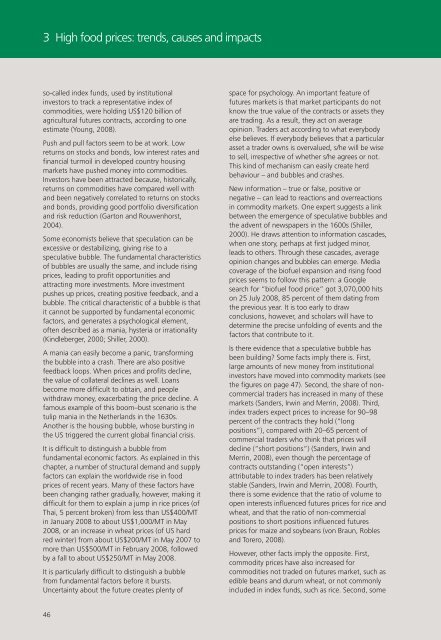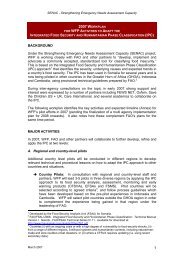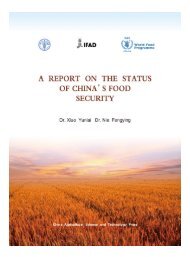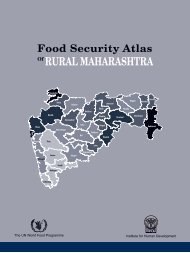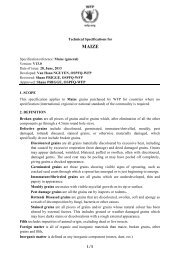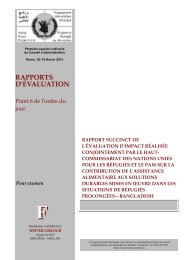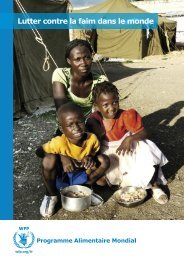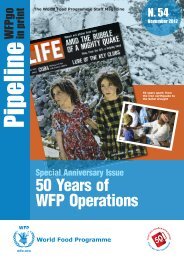Intermezzo 3.2: Did speculation push up food prices <strong>and</strong> create a bubble?When a phenomenon such as high food prices isdifficult to explain <strong>and</strong> affects many peoplenegatively, “speculators” are often blamed. Theywere blamed in 1958 when onion prices soared, inthe first half of the 1970s <strong>and</strong> again in 2008. Isthere any ground for this?Hedging <strong>and</strong> speculation: two sides of thesame coinWhat the media <strong>and</strong> politicians label as speculationis a critical market function. Economists definespeculation as buying <strong>and</strong> selling to make profitsfrom price changes. This is in contrast to buying<strong>and</strong> selling for use, to generate income as aninvestment, or to add value through transformationor transportation. Speculation in commoditiesinvolves buying <strong>and</strong> selling futures contracts –pieces of paper. Without it, traders would have tobuy, sell – <strong>and</strong> store – the actual commodities.A futures contract guarantees the price its holderwill pay or receive for a good at a certain deliverydate. This is very useful for farmers in reducing risk,particularly when there is a time lag betweenspending on inputs, such as seeds <strong>and</strong> fertilizer,<strong>and</strong> receiving revenues from harvested crops sales.When a farmer decides what to grow, s/he wouldlike to know, or even lock in, the price s/he willreceive for the crop. A farmer can do this byhedging in the futures market. The farmer sells afutures contract that commits her/him to deliver,say, 1 MT of wheat six months from now at acertain price. If the actual price in the market ishigher at the delivery date, the farmer will lose onthe futures contract, but gain by selling the crop ata higher price than expected. If the actual price inthe market is lower at the delivery date, the farmerwill gain on the futures contract, but lose by sellingthe crop at a lower price.For every seller, there is a buyer. What the farmersells, a speculator buys. A futures contract transfersthe price risk from the farmer to the speculator. Thecommodities underlying futures contracts areseldom delivered. On large futures markets, such asin Chicago or London, there is very active trade infutures contracts, which traders buy <strong>and</strong> sell beforethey expire. Most traders offset their contractsbefore they expire, with each party to the originalcontract selling/buying an opposite futurescontract.Because the contracts are not related to actualdeliveries, the number of futures contracts isunlimited. In a way, futures contracts are bets onthe future price of a commodity. The volume ofunderlying commodities exceeds the volumeactually harvested (OECD, 2008).There are thus two kinds of participants in futuresmarkets. The hedgers are the farmers, commercialtraders <strong>and</strong> processors who want to hedge againstthe price risks they face, <strong>and</strong> who are heavilyinvolved in actual deliveries of commodities. Thespeculators are the non-commercial traders whoseek profits through speculation <strong>and</strong> are often notinvolved in delivering commodities. Hedgers <strong>and</strong>speculators are two sides of the same coin.Speculation <strong>and</strong> pricesDo prices quoted in futures contracts have aneffect on spot prices? For actual deliveries, thefutures price should be equal to the spot price plusthe storage <strong>and</strong> insurance costs of holding thecommodities until the contract expires. As thatdate approaches, the spot <strong>and</strong> futures pricesshould converge. Arbitrageurs make sure that thishappens. If, for example, the futures price isconsidered too high, arbitrageurs will sell a futurescontract, buy the commodity, store it <strong>and</strong> deliver itwhen the contract expires, making a profit bydoing so (OECD, 2008).One anomaly of the commodities markets is thatspot <strong>and</strong> futures prices do not always converge atthe time of delivery, for example in the maize,wheat <strong>and</strong> soybean markets (OECD, 2008).Another anomaly is that the difference betweenspot <strong>and</strong> futures prices seems to be widening.These anomalies reduce the usefulness of thefutures market in transferring risk, <strong>and</strong> are difficultto explain. A lack of convergence could be causedby storage problems, but some argue that largeamounts of new money from institutional investorsare distorting the markets. Further research isneeded, but the coincidence of these anomalieswith the influx of new money has raised suspicions.A speculative bubble?The amount of money that institutional investorsput into commodities has increased rapidly inrecent years. The number of futures contractsdoubled or tripled between the end of 2004 <strong>and</strong>2006 (see the figures on page 47). In early 2008,45
3 High food prices: trends, causes <strong>and</strong> impactsso-called index funds, used by institutionalinvestors to track a representative index ofcommodities, were holding US$120 billion ofagricultural futures contracts, according to oneestimate (Young, 2008).Push <strong>and</strong> pull factors seem to be at work. Lowreturns on stocks <strong>and</strong> bonds, low interest rates <strong>and</strong>financial turmoil in developed country housingmarkets have pushed money into commodities.Investors have been attracted because, historically,returns on commodities have compared well with<strong>and</strong> been negatively correlated to returns on stocks<strong>and</strong> bonds, providing good portfolio diversification<strong>and</strong> risk reduction (Garton <strong>and</strong> Rouwenhorst,2004).Some economists believe that speculation can beexcessive or destabilizing, giving rise to aspeculative bubble. The fundamental characteristicsof bubbles are usually the same, <strong>and</strong> include risingprices, leading to profit opportunities <strong>and</strong>attracting more investments. More investmentpushes up prices, creating positive feedback, <strong>and</strong> abubble. The critical characteristic of a bubble is thatit cannot be supported by fundamental economicfactors, <strong>and</strong> generates a psychological element,often described as a mania, hysteria or irrationality(Kindleberger, 2000; Shiller, 2000).A mania can easily become a panic, transformingthe bubble into a crash. There are also positivefeedback loops. When prices <strong>and</strong> profits decline,the value of collateral declines as well. Loansbecome more difficult to obtain, <strong>and</strong> peoplewithdraw money, exacerbating the price decline. Afamous example of this boom–bust scenario is thetulip mania in the Netherl<strong>and</strong>s in the 1630s.Another is the housing bubble, whose bursting inthe US triggered the current global financial crisis.It is difficult to distinguish a bubble fromfundamental economic factors. As explained in thischapter, a number of structural dem<strong>and</strong> <strong>and</strong> supplyfactors can explain the worldwide rise in foodprices of recent years. Many of these factors havebeen changing rather gradually, however, making itdifficult for them to explain a jump in rice prices (ofThai, 5 percent broken) from less than US$400/MTin January 2008 to about US$1,000/MT in May2008, or an increase in wheat prices (of US hardred winter) from about US$200/MT in May 2007 tomore than US$500/MT in February 2008, followedby a fall to about US$250/MT in May 2008.It is particularly difficult to distinguish a bubblefrom fundamental factors before it bursts.Uncertainty about the future creates plenty ofspace for psychology. An important feature offutures markets is that market participants do notknow the true value of the contracts or assets theyare trading. As a result, they act on averageopinion. Traders act according to what everybodyelse believes. If everybody believes that a particularasset a trader owns is overvalued, s/he will be wiseto sell, irrespective of whether s/he agrees or not.This kind of mechanism can easily create herdbehaviour – <strong>and</strong> bubbles <strong>and</strong> crashes.New information – true or false, positive ornegative – can lead to reactions <strong>and</strong> overreactionsin commodity markets. One expert suggests a linkbetween the emergence of speculative bubbles <strong>and</strong>the advent of newspapers in the 1600s (Shiller,2000). He draws attention to information cascades,when one story, perhaps at first judged minor,leads to others. Through these cascades, averageopinion changes <strong>and</strong> bubbles can emerge. Mediacoverage of the biofuel expansion <strong>and</strong> rising foodprices seems to follow this pattern: a Googlesearch for “biofuel food price” got 3,070,000 hitson 25 July 2008, 85 percent of them dating fromthe previous year. It is too early to drawconclusions, however, <strong>and</strong> scholars will have todetermine the precise unfolding of events <strong>and</strong> thefactors that contribute to it.Is there evidence that a speculative bubble hasbeen building? Some facts imply there is. First,large amounts of new money from institutionalinvestors have moved into commodity markets (seethe figures on page 47). Second, the share of noncommercialtraders has increased in many of thesemarkets (S<strong>and</strong>ers, Irwin <strong>and</strong> Merrin, 2008). Third,index traders expect prices to increase for 90–98percent of the contracts they hold (“longpositions”), compared with 20–65 percent ofcommercial traders who think that prices willdecline (“short positions”) (S<strong>and</strong>ers, Irwin <strong>and</strong>Merrin, 2008), even though the percentage ofcontracts outst<strong>and</strong>ing (“open interests”)attributable to index traders has been relativelystable (S<strong>and</strong>ers, Irwin <strong>and</strong> Merrin, 2008). Fourth,there is some evidence that the ratio of volume toopen interests influenced futures prices for rice <strong>and</strong>wheat, <strong>and</strong> that the ratio of non-commercialpositions to short positions influenced futuresprices for maize <strong>and</strong> soybeans (von Braun, Robles<strong>and</strong> Torero, 2008).However, other facts imply the opposite. First,commodity prices have also increased forcommodities not traded on futures market, such asedible beans <strong>and</strong> durum wheat, or not commonlyincluded in index funds, such as rice. Second, some46
- Page 1 and 2: World Hunger SeriesHunger and Marke
- Page 3: World Hunger SeriesHunger and Marke
- Page 6 and 7: ForewordHunger is on the march thro
- Page 8 and 9: FiguresFigure 1.1 - The hunger-pove
- Page 10 and 11: OverviewWell-functioning food marke
- Page 12 and 13: exclude small-scale farmers, but th
- Page 16: Part I Setting the StageHigh food p
- Page 19 and 20: 1 HungerWhat is hunger?Most people
- Page 21: 1 Hungermarginalized or discriminat
- Page 24 and 25: 2 Markets“No single solution to [
- Page 26 and 27: Market failuresEconomists identify
- Page 28 and 29: Figure 2.2 - Marketing margins for
- Page 30 and 31: policies, may change the incentives
- Page 32 and 33: Intermezzo 2.1: The Chinese model -
- Page 34 and 35: Table 3.1 - Factors causing high fo
- Page 36 and 37: Demand and supply curves are steep,
- Page 38 and 39: Exchange rates are another major fa
- Page 40 and 41: Impact on householdsHigher food pri
- Page 42 and 43: Global financial crisisThe high foo
- Page 44 and 45: Intermezzo 3.1: The “Dismal Scien
- Page 48 and 49: Wheat prices and open positions on
- Page 50 and 51: Intermezzo 3.3: The cost-of-food-ba
- Page 52: Region Country Main staple Caloric
- Page 56 and 57: 4 Households, hunger and markets“
- Page 58 and 59: Assets• Financial assets: cash, s
- Page 60 and 61: Urban households and marketsBy 2020
- Page 62 and 63: Table 4.1 - Participation in staple
- Page 64 and 65: 5 Access to markets“Interventions
- Page 66 and 67: Another market imperfection is that
- Page 68 and 69: Rural labour markets: voices from R
- Page 70 and 71: Figure 5.1 - Agricultural producer
- Page 72 and 73: Figure 5.2 - Notifications of new S
- Page 74 and 75: The importance of vertical coordina
- Page 76 and 77: Intermezzo 5.1: Purchase for progre
- Page 78 and 79: WFP farmer groups: net revenues (20
- Page 80 and 81: Figure 6.1 - Daily per capita calor
- Page 82 and 83: Figure 6.3 - Global cereal stocks a
- Page 84 and 85: the rest of the country. For exampl
- Page 86 and 87: Figure 6.8 - Wheat prices and direc
- Page 88 and 89: Figure 6.9 - Relation between the f
- Page 90 and 91: however, and 56 percent of househol
- Page 92 and 93: Table 1 - Informal maize imports an
- Page 94 and 95: Intermezzo 6.2: Food assistance and
- Page 96 and 97:
7 Vulnerability, risk and markets
- Page 98 and 99:
Lessons learned from the 2005 food
- Page 100 and 101:
Figure 7.2 - Terms of trade between
- Page 102 and 103:
SharecroppingIn sharecropping syste
- Page 104 and 105:
Poor households can also reduce the
- Page 106 and 107:
female-headed households often rely
- Page 108 and 109:
8 Markets in emergencies“Most dec
- Page 110 and 111:
To respond to a shock, family membe
- Page 112 and 113:
Figure 8.4 - Sorghum price differen
- Page 114 and 115:
Table 8.1 - Impact of a drought on
- Page 116 and 117:
Intermezzo 8.1: Market analysis in
- Page 120:
Part III Actions and the Way Forwar
- Page 123 and 124:
9 Making markets work for the hungr
- Page 125 and 126:
9 Making markets work for the hungr
- Page 127 and 128:
9 Making markets work for the hungr
- Page 129 and 130:
9 Making markets work for the hungr
- Page 131 and 132:
9 Making markets work for the hungr
- Page 133 and 134:
9 Making markets work for the hungr
- Page 135 and 136:
9 Making markets work for the hungr
- Page 137 and 138:
9 Making markets work for the hungr
- Page 139 and 140:
9 Making markets work for the hungr
- Page 141 and 142:
10 The way forward: ten market-base
- Page 143 and 144:
10 The way forward: ten market-base
- Page 145:
10 The way forward: ten market-base
- Page 149 and 150:
Resource compendiumTable 1 - Hunger
- Page 151 and 152:
Resource compendiumUndernourishment
- Page 153 and 154:
Resource compendiumTable 2 - Food a
- Page 155 and 156:
Resource compendiumDietary energy c
- Page 157 and 158:
Resource compendiumDietary energy c
- Page 159 and 160:
Dietary energy consumption (kcal/pe
- Page 161 and 162:
Table 3 - International assistanceA
- Page 163 and 164:
Resource compendiumAverage annual f
- Page 166:
Part V AnnexesAbbreviations and acr
- Page 169 and 170:
Abbreviations and acronymsUNCTADUND
- Page 171 and 172:
GlossaryEntitlementsThe set of alte
- Page 173 and 174:
GlossaryPurchasing powerThe quantit
- Page 175 and 176:
BibliographyBehrman, J.R., Alderman
- Page 177 and 178:
Bibliographyde Brauw, A. & Hoddinot
- Page 179 and 180:
BibliographyFarina, E.M.M.Q. & Rear
- Page 181 and 182:
BibliographyJayne, T.S. & Jones, S.
- Page 183 and 184:
BibliographyMittal, A. & Mousseau,
- Page 185 and 186:
BibliographySen, A. 1981. Poverty a
- Page 187 and 188:
BibliographyWFP. 2004. WFP and Food
- Page 189:
Methodology for mapsCountry boundar
- Page 193:
“Left to their own devices, marke


